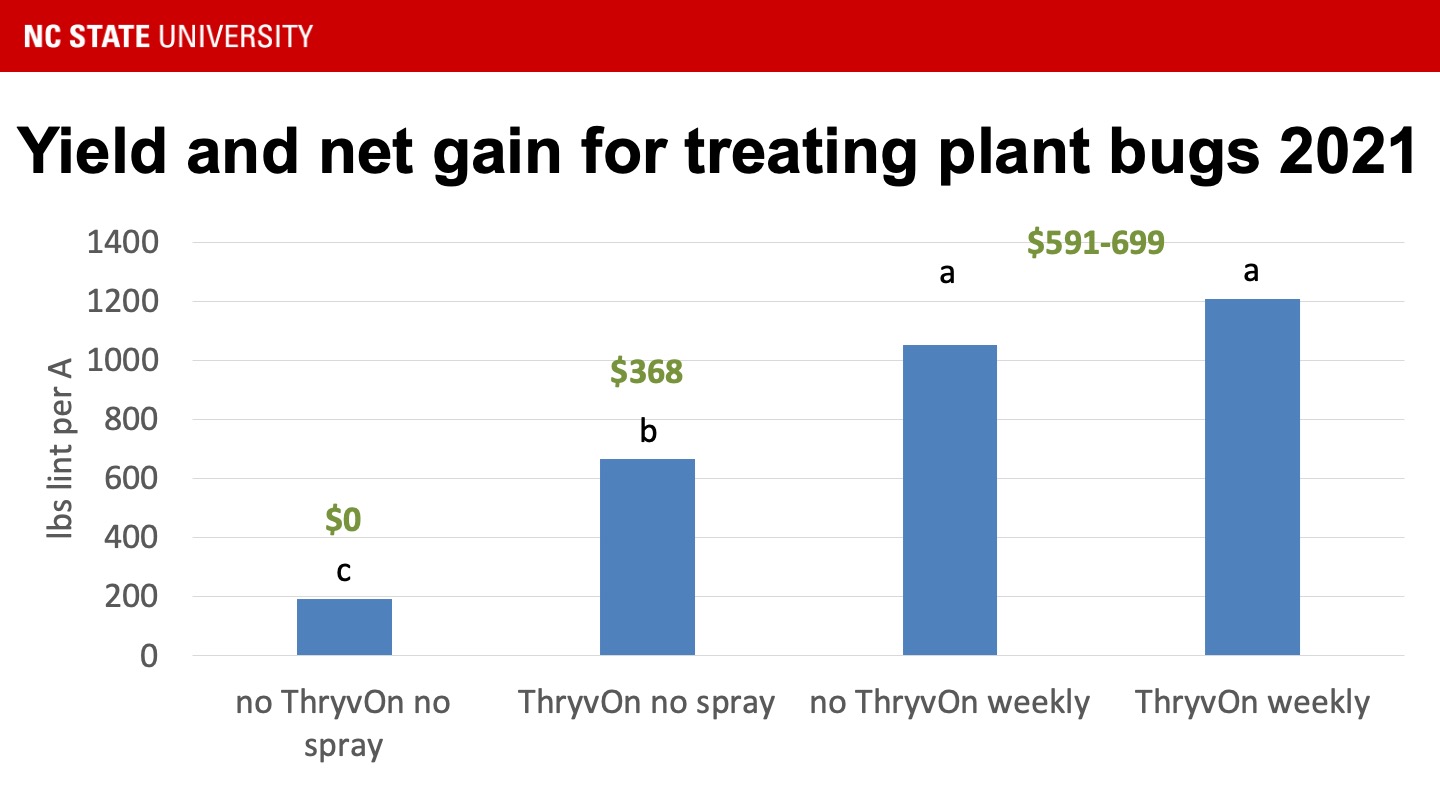Should You Treat ThryvOn Cotton With Insecticide?
go.ncsu.edu/readext?1005035
en Español / em Português
El inglés es el idioma de control de esta página. En la medida en que haya algún conflicto entre la traducción al inglés y la traducción, el inglés prevalece.
Al hacer clic en el enlace de traducción se activa un servicio de traducción gratuito para convertir la página al español. Al igual que con cualquier traducción por Internet, la conversión no es sensible al contexto y puede que no traduzca el texto en su significado original. NC State Extension no garantiza la exactitud del texto traducido. Por favor, tenga en cuenta que algunas aplicaciones y/o servicios pueden no funcionar como se espera cuando se traducen.
Português
Inglês é o idioma de controle desta página. Na medida que haja algum conflito entre o texto original em Inglês e a tradução, o Inglês prevalece.
Ao clicar no link de tradução, um serviço gratuito de tradução será ativado para converter a página para o Português. Como em qualquer tradução pela internet, a conversão não é sensivel ao contexto e pode não ocorrer a tradução para o significado orginal. O serviço de Extensão da Carolina do Norte (NC State Extension) não garante a exatidão do texto traduzido. Por favor, observe que algumas funções ou serviços podem não funcionar como esperado após a tradução.
English
English is the controlling language of this page. To the extent there is any conflict between the English text and the translation, English controls.
Clicking on the translation link activates a free translation service to convert the page to Spanish. As with any Internet translation, the conversion is not context-sensitive and may not translate the text to its original meaning. NC State Extension does not guarantee the accuracy of the translated text. Please note that some applications and/or services may not function as expected when translated.
Collapse ▲The short answer for thrips is no, and for plant bugs, yes, if it hits threshold. We covered this in a 2023 article, but here is some more justification.
Thrips
ThryvOn cotton is an egg-laying and feeding deterrent for thrips. Because it only deters, but doesn’t eliminate them, we can expect to find larval thrips on ThryvOn cotton. However, numbers on ThryvOn will be greatly reduced relative to non-ThryvOn cotton. In my experience, there are generally 5-10x fewer thrips on ThryvOn cotton relative to non-ThryvOn cotton. This varies greatly with environment.
In North Carolina, we have evaluated the effect of ThyrvOn for thrips in multiple small-plot experiments since 2014. We also tested this on-farm in 2022 and 2023 in Nash and Edgecombe counties using whole fields instead of small plots. Numbers were very high in 2022 and they provided an excellent estimate for how ThryvOn could perform. We treated some ThryvOn fields with 5lbs. AgLogic and left other ThryvOn fields untreated.
At 28 days after planting, thrips numbers soared to an average of 6.5 per plant in ThryvOn + AgLogic and 21.2 per plant in ThryvOn alone. Keep in mind our economic threshold (when it pays to spray) is 2 larval thrips per plant.
Injury was high at this point, as well. On a scale of 1-5 (1 = no injury, 2.5 = yield loss likely, 5 = dead plant), injury averaged 1.25 in ThryvOn + AgLogic and 2.25 in ThryvOn alone.
This persisted during the early season. In fact, plants treated with AgLogic had a higher vigor and were taller. However, at the end of the season, yields were statistically the same (ThryvOn + AgLogic = 1162 lbs. lint and ThryvOn alone = 1166 lbs. lint). We have seen this phenomenon time and again in small plots as well.
For example, because cotton did not grow quickly in May and early June, 2023 was a high pressure year across the state. Despite this, ThryvOn + AgLogic yielded 1595 lbs. lint and ThryvOn alone yielded 1527 lbs. lint in small plot trials at Plymouth, NC. Note that these yields were statistically the same, just like the on-farm tests.
To my knowledge, no university extension trial in the Cotton Belt has shown a yield benefit to treating thrips in ThryvOn cotton. You can reduce thrips and improve appearance, vigor, and even plant height, but not yield. Therefore, you should not treat thrips in ThryvOn cotton.
Tarnished plant bug
Similar to thrips, ThryvOn cotton is an egg-laying and feeding deterrent to tarnished plant bug. However, it will need to be treated if the economic threshold (when it pays to spray) is reached.
A good example of the benefit of ThryvOn alone, and the benefit of ThryvOn protected from the insecticide, is from our 2021 trial. Note that ThryvOn does not need protected with weekly sprays. Our current economic thresholds work fine. In fact, we have experiments in place to see if we can relax our thresholds for ThryvOn cotton. However, check out the benefit of spraying when tarnished plant bug pressure is high.

Lint yield for non-ThryvOn and ThryvOn cotton, both sprayed weekly (5x) and unsprayed for tarnished plant bug. Letters that are different mean yields are significantly different. Dollar figures represent net gain for treating tarnished plant bug, including lint yield profit, minus the cost of the insecticide application and cost of the ThryvOn trait.
This trial clearly demonstrates that ThryvOn alone provides some protection from tarnished plant bug. However, under moderate to high-pressure tarnished plant bug scenarios, yield can be improved with foliar insecticides.



